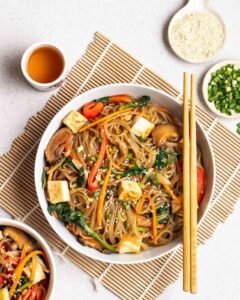The rise of Korean culture and customs has been phenomenal. People all around the world are diving deep into the South Korean way of doing things; be it their enigmatic and versatile music or their heartfelt and engaging drama shows. Curiosity around the nation has increased in many aspects, one of the most significant ones being its food. A lot of Korean history and nostalgic grandma tales are tied to the traditional dishes of the land. Throughout this list, common elements in the food like tanginess, sourness, spice, and more can be noticed- all indicative of the connection with food that Koreans have. Here are some of their most iconic creations.
Kimchi
Every time you visit a Korean or pan-Asian restaurant, the first thing they serve after the welcome drink is a bowl of coated, flavorful cabbage. Oh, turns out this appetizer is actually amazing and addictive! That exactly, is Kimchi. It is salted and fermented vegetables, along with generous seasonings and spices too. There are traditional and modern processes too, but both of them yield some refreshing and acidic Kimchi that blends in with all sorts of main course dishes, especially the rich and heavy ones with need some help to cut through. It also has some Chinese and Japanese variations.

Samgyeopsal
Samgyeopsal is an indulgent pork belly dish. It has three layers of eat- the fat of the pork belly and the two smaller layers of meat beneath it- the lighter part and darker part. It is a prominent dish in Korean barbeques, which have taken the culinary world by storm. Korean barbeque restaurants and traditions promote an exhilarating level of opportunity for customization. Dips, sauces, vegetables, kimchi… Everything you name will be a great compliment for the star meat. The classic gochugaru, then vinegar, salt, and sugar are the important ingredients.

Gochujang
In Samgyeopsal, one of the major ingredients is a Korean food item called Gochugaru. Basically, gochugaru is a type of dried chilli flakes. A mixture of these chilli flakes blended or mixed up with sticky rice, slat, and more is called gochujang. In recent years, it has become a frequent condiment in countries foreign to South Korea too. It is widely used in noodle dishes; with soba, glass noodles, buckwheat noodles, etc. It has a tangy and funky taste. The umami undertone is strong and the spice also contributes to its appeal. It can be stored for a long period of time and comes in handy for some good last-minute flavor rectifications.

Japchae
Japchae’s only apt description is as follows: ‘heaven on a plate’! One of its most remarkable characteristics is that it is equally delicious in all its versions- be it the vegetarian ones or the ones dense with meat. Japchae is made out of glass noodles, which are made of potato starch. The noodles have a really light and bouncy texture. They are perfect for a cold noodle dish. A plethora of vegetables are included in Japchae- basically anything of one’s preference. It also carries the resonant umami flavor that comes with all the seasonings and sauces mixed into the noodles.

Korean Corn Dog
One of the hottest food trends recently has been the Korean hot dog. This dish features a sausage that is dipped in a thick and stickily dense batter. Later, the covered sausage attached to a stick would be covered by some of the most indulgent cheeses. Then comes a layer of egg wash (only sometimes) and crunchy breadcrumbs. When this is fried, it transforms into a melty, wholesome, and awesome snack. Food content creators and influencers got truly creative with their alterations. Some switched the breadcrumbs for Cheetos dust, or even crushed cornflakes. Even hit dog stands have begun selling this dish.

Korean Fried Chicken
Korean fried chicken has become a huge hit in the west. It is a breath of fresh air for the public that has been savoring almost identical seasoning mixes across all those fast food restaurant chains. The major food chains of the day stick to a very similar formula for their seasonings, and naturally, after the initial highs, their consumers lose interest in it. At such a time entered the Korean Fried Chicken! This dish is light yet crispy and delivers a bold flavour with a spicy-sweet chili sauce. The sesame seeds sprinkled on top mark the distinguishable quality of this dish.

Jajangmyeon
‘Jajangmyeon’ translates to ‘black bean paste’. People have been getting on the bandwagon of black bean paste noodles and almost each one of them has been amazed by its remarkable and one-of-a-kind flavor. It is a very common dinner dish. For most non vegetarians, the main protein is the dicep pork. Meanwhile, the vegetables and textures provide anticipation enough for the vegetarians. Oyster sauce is also one of the key ingredients. The consistency of the sauce before combining it with the cooked noodles is like that of a thick gravy. It is a crowd favourite dish.
Korean Pancakes
Traditional Korean pancakes are the kind of dish that stand alone efficiently and need no additional sides to keep your stomach and heart satisfied. Loading on some good fiber, vegetables like green onions, red onions, carrots, and further optional veggies act as the main ingredients. Then come the seasonings, corn starch, rice flour, and baking powder. It is commonly called ‘Buchimgae’ and alongside is served an acidic dipping sauce composed of soy sauce, vinegar, sesame, flavored oil, and more delectable stuff. They are very filling and therefore great to start the day with. Never forget those good-old crunchy sesame seeds sprinkled on top!
Korea truly is a land of wonders and has an infinite amount of impressive parts to show the world. Food is a glorious component of South Korean culture, and it is essential to honor the authenticity and significance of all these delicacies.






